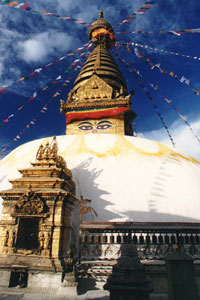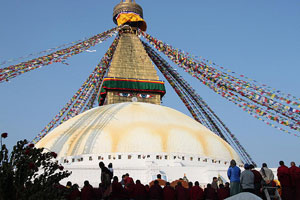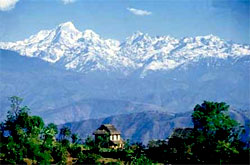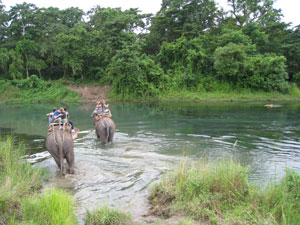Places to See in Nepal

Most of the heritage sites of Nepal are in the Kathmandu valley. The Kathmandu valley consists of two medieval towns of Patan and Bhaktapur and the capital of Nepal, Kathmandu itself. On the outskirts of Kathmandu are interesting medieval towns of Panauti, Dhulikhel and Kirtipur, all of them are interesting tourist destinations for one or the other reasons.
These three cities are like open museum of medieval arts, culture and tradition.
There are seven world heritage sites declared by UNESCO within a periphery of about thirty kilometer in this valley.
Kathmandu
The Kathmandu Durbar square , located on the heart of Kathmandu is the place to look for most of Kathmandu's temples, old palaces and interesting old quarter of the city. Here you will see several temples built on 15th and 16th centuries, the famous courtyard of the living goddess Kumari, active temples being worshipped by the devotees. Equally interesting would be the traditional market place with fruit and vegetable sellers and antique and painting shops.
Bhaktapur
Bhaktapur , 14 km east of Kathmandu is a completely medieval world and a must in your itinerary. With its well preserved temples and monuments , the peasants and artisans, the town will take you in its spell. The whole town has almost no concrete buildings, life is buildings are traditional and peaceful.This well preserved city is the home of medieval art & architecture and still retains its rich medieval aroma. A city of farmers, Bhaktapur is also known for it's pottery and weaving. Bhaktapur is the most charming and the best preserved of the valleys three cities. The intricately carved temples, alleyways and timeless atmosphere of this place is simply intriguing. The major sightseeing places in Bhaktapur are The Durbar square , the Golden Gate, Palace of 55 windows, Bell of the barking dogs, 5 storied Nyatapole Temple, Bhairavanath Temple, Dattatrya Temple, Pujari Math etc Bhaktapur can be done along with a hike to Changunarayan temple or a visit to Nagarkot.
Patan
 Patan is also known as Lalitpur or the "city of fine arts" and is the oldest city in the valley. This Buddhist City is said to have been founded by the Buddhist Emperor Ashoka in the 3rd century BC. Patan is the source of arts and architecture of the valley, a great center both of the Newari Buddhist religion and of traditional arts & crafts with 136 bahals or courtyards and 55 major temples. Well known among these are the Krishna Mandir, Hiranya Varna Mahavihar, Kumbheshwar temple, Jagatnarayan temple & the Mahabouddha temple. Patan is enclosed within 4 Buddhist stupas set on the four-corners of the outer boundaries of this ancient city. A tour of Patan would also include a visit to the Tibetan refugee camp to witness the hand weaving of Tibetan carpets using age-old methods of dyeing and finishing.The central zoo of nepal is near by and has interesting varities of wild animals.
Patan is also known as Lalitpur or the "city of fine arts" and is the oldest city in the valley. This Buddhist City is said to have been founded by the Buddhist Emperor Ashoka in the 3rd century BC. Patan is the source of arts and architecture of the valley, a great center both of the Newari Buddhist religion and of traditional arts & crafts with 136 bahals or courtyards and 55 major temples. Well known among these are the Krishna Mandir, Hiranya Varna Mahavihar, Kumbheshwar temple, Jagatnarayan temple & the Mahabouddha temple. Patan is enclosed within 4 Buddhist stupas set on the four-corners of the outer boundaries of this ancient city. A tour of Patan would also include a visit to the Tibetan refugee camp to witness the hand weaving of Tibetan carpets using age-old methods of dyeing and finishing.The central zoo of nepal is near by and has interesting varities of wild animals.
Swoyambhunath Stupa
About 45 min of walk from city centre ,atop a green hillock west of Kathmandu stands the great stupa of Swayambhunath, a site over 2,500 years old marking the point where the legendary patriarch Manjushri discovered the lotus of the ancient Valley lake. For centuries an important center of Buddhist learning, the painted eyes of the Buddha gaze out from all four sides of the monument. Constructed to specific rules each with a symbolic meaning, the stupa of Swayambhunath is a model of its kind. The whole is hung with multi-colored prayer flags whose every flutter releases holy prayers. The faithful circumambulate the stupa clockwise, turning the banks of prayer wheels and even prostrating full-length in reverence.
Swoyambhunath commands great view of Kathmandu valley and the Himalayas and a visit around sunset time will be highly enjoyed.
Bouddhanath stupa
 The stupa of Bodhanath lies 8 km east of Kathmandu. It is the biggest Stupa in Nepal and the Pilgrimmage centre for great number of Tibetan refugees living in Nepal., Many Tibetan Lamas and Rinpoches reside in surrounding area.Kathmandu is a better place than Tibet or even Dharmashala to learn Tibetan Buddhism as the atmosphere here is not politically charged.This colossal Stupa is set on concentric ascending terraces in the powerful pattern of a Mandala. Around the base of this strikingly enormous and simple stupa is a ring of 108 images of the Buddha and 147 insets.
The stupa of Bodhanath lies 8 km east of Kathmandu. It is the biggest Stupa in Nepal and the Pilgrimmage centre for great number of Tibetan refugees living in Nepal., Many Tibetan Lamas and Rinpoches reside in surrounding area.Kathmandu is a better place than Tibet or even Dharmashala to learn Tibetan Buddhism as the atmosphere here is not politically charged.This colossal Stupa is set on concentric ascending terraces in the powerful pattern of a Mandala. Around the base of this strikingly enormous and simple stupa is a ring of 108 images of the Buddha and 147 insets.
Pashupatinath temple
It is situated 5 kms east of Kathmandu on the banks of the sacred Bagmati River. The temple of lord Shiva, Pashupatinath, with a tiered golden roof & silver doors is famous for its superb architecture. Entrance to the temple precinct is forbidden to non-Hindus. The best view is from the terrace on the wooded hill across the river. The large gilded triple-roofed temple was built in 1696 AD though 300 years earlier there was a structure on this site. The Bagmati River is lined with dharmasalas and cremation ghats .There is usually a cremation in progress on one of the platforms by the river, regarded as holy as it flows into the sacred Ganges. There are many occasions when the faithful take ritual baths in the river. One of the most colorful is the women's festival of Teej when dressed in their finest red and gold saris hundreds of women, laughing and singing converge on Pashupatinath. Another great time to be here is the Festival of Shivaratri, the birthday of lord Shiva.
Changunarayan temple
18 kms east of Kathmandu and a 45 minutes walk up from Bhaktapur lies the beautiful temple of Changunarayan , at the end of a ridge.Changunarayan is the oldest temple in Kathmandu valley dating back 467 AD. The lavishly decorated two-tiered temple was rebuilt after a fire in 1702, testifies to the considerable talents of the Licchavi King Mandeva I, Nepals first great historical figure. The temple stands in a spacious courtyard, with priceless stone sculptures,and writings on copper plates and stone slabs from the 4th to 9th century A.D. (Licchavi period). produced masterpieces that were entirely. Changunaryan is a world heritage site declared by UNESCO. There is a pleasant day hike from Nagarkot to Changunarayan.
Dakshinkali temple
Dakshinkali is 45-minute drive south from Kathmandu. Located inside a lovely forest at the confluence of two streams, the shrine of Dakshinkali is the most spectacular of all Kali temples. Animal sacrifices are offered to this deity signifying fertility and the procreative powers of the Female, every Tuesday & Saturday. The animals are presented to the priest who will ritually decapitate them with a khukuri knife & bathe the black stone image of Kali in blood.
Bungmati and Khokana and Pharping
The twin villages of Bungmati & Khokana date from the 16th century and are located south of Kathmandu, down a rutty road dotted with Chaityas. Bungmati is the winter home of lord Rato Machhendranath, the protector God of Patan. The shrine of Karya Binayak is located between the two villages. At Khokana ancient oil presses can be seen at work in village houses. Bungmati , Khokana and the nearby village of Pharping are the places to see traditional Newari villages in their traditional way.
Kopan Monastery
A center of Mahayana Buddhism was established in 1969 by two Lamas; Lama Thupten Zopa Rinpoche & Lama Thupten Yeshe. Since its inception the center has been responsible for introducing thousands to Buddha's teaching through meditation courses, lectures & retreats.
Shivapuri
Shivapuri, at a height of 2,732m, allows one a 360 degree view of the Himalaya in the north & the Kathmandu valley in the south. The trail up to Shivapuri hill leads through small farming villages & a protected forest of Rhododendrons & orchids with little mountain streams running through it. This can be made into a most enjoyable full day's programme.
Namo Buddha
Namo Buddha meaning "hail to the Buddha" a sacred site, where according to legend Buddhist prince sacrificed his body to feed a starving tigress & her cubs. A carved stone slab at the main stupa depicts the moving story.Buddhist pilgrims from all over the hills visit this stupa.It is a lovely day hike from Dhulikhel to Namobuddha and back to Panauti.
Nagarkot
 The tiny settlement of Nagarkot clings to a hilltop 36 kms east of Kathmandu at an altitude of 2100m. It is one of the best vantage point to view the peaks - from the Annapurnas to Everest, the peaks seem no more than a day's walk away.The sunset and sunrise view over the Himalayan panorama from Nagarkot is a memory of lifetime for many. It is also possible to do a day hike from Nagarkot to Dhulikhel along the valley rim.
The tiny settlement of Nagarkot clings to a hilltop 36 kms east of Kathmandu at an altitude of 2100m. It is one of the best vantage point to view the peaks - from the Annapurnas to Everest, the peaks seem no more than a day's walk away.The sunset and sunrise view over the Himalayan panorama from Nagarkot is a memory of lifetime for many. It is also possible to do a day hike from Nagarkot to Dhulikhel along the valley rim.
Dhulikhel
30 kms east of Kathmandu lies the small resort town of Dhulikhel set on a hill top, enveloped in copper soiled terraces with magnificent views of the central Himalayan peaks. Dhulikhel is well known for its sunrise views and a number of day trails lead along the north ridge of the town.
Outside Kathmandu valley
Pokhara
Pokhara valley is a scenic 6-hour mountainside drive or a 25 minute flight west of Kathmandu. It is famous for its lakes and its location beneath the towering Annapurna massif. It is highly recommendable to visit this scenic valley, stay in small resort hotels with views of the magnificent Himalayan peaks, go boating on the calm waters of the Phewa and the Begnas lakes or go on tours or day hikes in the nearby hills or if time permits, on a well organized trekking holiday to the base camp of the annapurnas.
Further 12 km east of Pokhara at the end of a road that turns north from highway to Kathmandu lies the Begnas Lake offering the perfect nature retreat because of its elative seclusion. Splendid hiking, boating and fishing opportunities can be found here. Trekking of different duration can be organised from Pokhara.
Chitwan
 About a 5 hour drive or a 30 min flight from Kathmandu lies the Chitwan National Park.This tropical national park is the home of rhinos, different species of deer , crocodile , leopard , Bengal tiger , peacock, wild cow, wild boar and a great number of bird species.More than 450 bird species are found in this National lpark.An elephant back safari in this park is highly recommended for every visitor in Nepal.Chitwan is at a distance of about 4-5 hour drive from Lumbini or Pokhara.
About a 5 hour drive or a 30 min flight from Kathmandu lies the Chitwan National Park.This tropical national park is the home of rhinos, different species of deer , crocodile , leopard , Bengal tiger , peacock, wild cow, wild boar and a great number of bird species.More than 450 bird species are found in this National lpark.An elephant back safari in this park is highly recommended for every visitor in Nepal.Chitwan is at a distance of about 4-5 hour drive from Lumbini or Pokhara.
Lumbini
Lumbini, the birthplace of lord Gautam Buddha, is the pilgrimage destination of the worlds millions of Buddhists. The main attraction at Lumbini remains the sacred garden spread over 8 sq. kms and possessing all the treasures of this historical area. The Mayadevi temple (under reconstruction) is the main attraction for pilgrims and archaeologists alike. This site, identified by the Indian Emperor Ashokas commemorative pillar is listed as a world heritage site by UNESCO. To the south of the pillar, we find the sacred pond Puskarni, where Queen Mayadevi had her bath just before giving birth to the Buddha. Other attractions include the various monasteries and stupas erected by different Buddhist countries.

 Most of the heritage sites of Nepal are in the Kathmandu valley. The Kathmandu valley consists of two medieval towns of Patan and Bhaktapur and the capital of Nepal, Kathmandu itself. On the outskirts of Kathmandu are interesting medieval towns of Panauti, Dhulikhel and Kirtipur, all of them are interesting tourist destinations for one or the other reasons.
Most of the heritage sites of Nepal are in the Kathmandu valley. The Kathmandu valley consists of two medieval towns of Patan and Bhaktapur and the capital of Nepal, Kathmandu itself. On the outskirts of Kathmandu are interesting medieval towns of Panauti, Dhulikhel and Kirtipur, all of them are interesting tourist destinations for one or the other reasons.